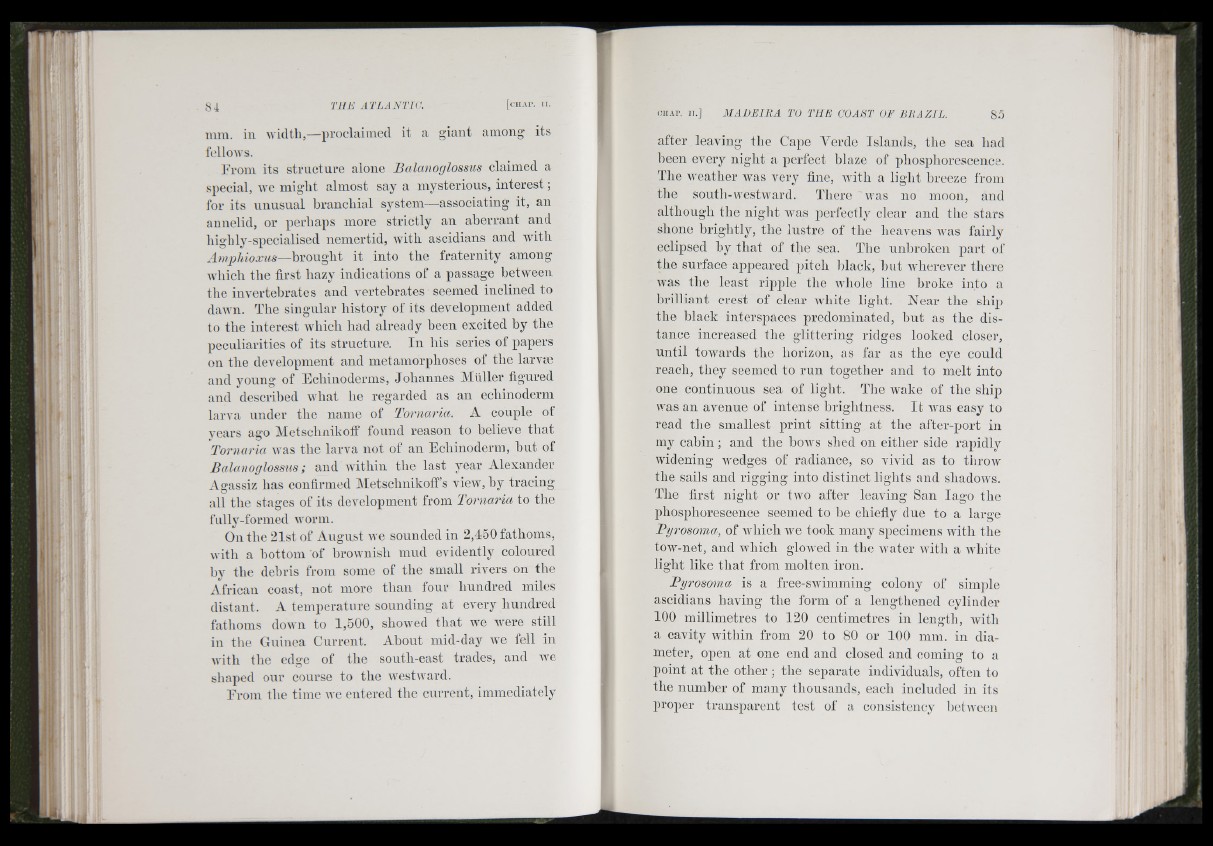
84
mm. in w id th ,-—
proclaimed it a giant among its
fellows.
From its structure alone Balanoglossus claimed a
special, a v c might almost say a mysterious, in te re s t;
for its unnsnal hranchial system—associating it, an
annelid, or perhaps more strictly an aherrant and
highly-specialised nemertid, Avitli ascidians and Avitli
brought it into the fraternity among
Avhich the first hazy indications of a passage between
the invertebrates and A'ertebrates seemed inclined to
daAvn. The singular history of its development added
to the interest Avhich had already been excited by the
peculiarities of its structure. In his series of papers
on the development and metamorphoses of the larvic
and young of Echinoderms, Johannes Müller figured
and described Avhat he regarded as an echinoderm
larva under the name of Tornaría. A couple of
years ago Metschnikoff found reason to believe th a t
Tornarla Avas the larva not of an Echinoderm, h u t of
Balanoglossus; and AA’ith in the last year Alexander
Agassiz has confirmed Metschnikoff’s v I c a v , hy tracing
all the stages of its development from Tornaría to the
fully-formed Avorm.
On th e 21st of A u g u s t Ave sounded in 2,450 fath om s,
A v i t h a b o ttom of hroAvnish m u d ev id en tly coloured
hy th e debris from some of th e small riv e rs on th e
A fric an coast, n o t mo re th a n fo u r h u n d re d miles
d is ta n t. A tem p e ra tu re so u n d in g a t every h u n d re d
fa th om s doAvn to 1,500, shoAved th a t aa^c Avere s till
in tlie G u in e a C u rre n t. A b o u t mid -d ay Ave fell in
Avith th e edge of th e so u th -e a st tra d e s, an d Ave
sh aped o u r course to th e Avestward.
From the time Ave entered the current, immediately
after leaving the Cape Verde Islands, the sea had
been every night a perfect blaze of phosphorescence.
The AA'eather Avas very fine, Avitli a light breeze from
the south-westAvard. There Avas no moon, and
although the night Avas perfectly clear and the stars
shone brightly, the lustre of the heavens Avas fairly
eclipsed hy th at of the sea. The unbroken p a rt of
the surface appeared pitch hlack, hut wherever there
Avas the least ripple the Avhole line broke into a
brilliant crest of clear Avliite light. Near the ship
the black interspaces predominated, b u t as the distance
increased the glittering ridges looked closer,
u n til toAvards the horizon, as far as the eye could
reach, they seemed to ru n together and to melt into
one continuous sea of light. The Avake of the ship
was an avenue of intense brightness. I t Avas easy to
read the smallest prin t sitting at the after-port in
my c ab in ; and the hoAvs shed on either side rapidly
widening AA^'edges of radiance, so vivid as to throAv
the sails and rigging into distinct lights and shadoAvs.
The first night or tAvo after leaving San lago the
phosphorescence seemed to he chiefly due to a large
Byrosoma, of Avhich Ave took many specimens Avith the
toAV-net, and Avhich gloAved in the Avater Avitli a Avliite
light like th a t from molten iron.
Byrosoma is a free-SAvimming colony of simple
a scidians h a v in g th e form of a len g th e n ed cy lin d e r
100 m illim e tre s to 120 c en tim e tre s in le n g th , Avitli
a c av ity Avitliin from 20 to 80 or 100 mm. in d ia m
e te r, open a t one end an d closed an d coming to a
p o in t a t th e o t h e r ; th e sep a ra te in d iv id u a ls, often to
th e n um b e r of m a n y th o u san d s , each in c lu d ed in its
pro p e r tr a n s p a r e n t te s t of a consistency lietweon